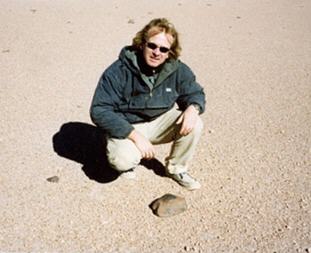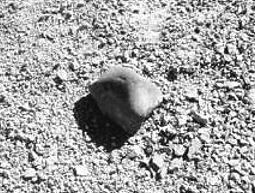EH7-anomalous or Meta-EH-an
(partial melt residue)

Fell ~1990
26° 35.45′ N., 12° 57.13′ W. Following a detonation with accompanying light, a stone weighing 410 g was found by a nomad in Saguia el Hamra, Western Sahara. In July of 2000, the Labenne family searched for meteorites in the same area near Itqiy, and Luc found a second stone that weighed 4,310 g. The large, smooth stone was covered with a thin, black fusion crustMelted exterior of a meteorite that forms when it passes through Earth’s atmosphere. Friction with the air will raise a meteorite’s surface temperature upwards of 4800 K (8180 °F) and will melt (ablate) the surface minerals and flow backwards over the surface as shown in the Lafayette meteorite photograph below. Click on Term to Read More still exhibiting flow lines. Although this meteoriteWork in progress. A solid natural object reaching a planet’s surface from interplanetary space. Solid portion of a meteoroid that survives its fall to Earth, or some other body. Meteorites are classified as stony meteorites, iron meteorites, and stony-iron meteorites. These groups are further divided according to their mineralogy and Click on Term to Read More has a low weathering grade (W1–2) consistent with a recent fallMeteorite seen to fall. Such meteorites are usually collected soon after falling and are not affected by terrestrial weathering (Weathering = 0). Beginning in 2014 (date needs confirmation), the NomComm adopted the use of the terms "probable fall" and "confirmed fall" to provide better insight into the meteorite's history. If Click on Term to Read More, 14C results infer a terrestrial age for Itqiy of 5,800 (±500) years. Initial classification of Itqiy was completed at the Lunar & Planetary Laboratory, University of Arizona.
Itqiy consists of ~78 vol% equigranular silicates composed of coarse-grained
enstatiteA mineral that is composed of Mg-rich pyroxene, MgSiO3. It is the magnesium endmember of the pyroxene silicate mineral series - enstatite (MgSiO3) to ferrosilite (FeSiO3). Click on Term to Read More with a size range of 0.5–4 mm. These are chemically similar to silicates in EL
chondritesChondrites are the most common meteorites accounting for ~84% of falls. Chondrites are comprised mostly of Fe- and Mg-bearing silicate minerals (found in both chondrules and fine grained matrix), reduced Fe/Ni metal (found in various states like large blebs, small grains and/or even chondrule rims), and various refractory inclusions (such Click on Term to Read More but have a significantly higher CaO content (Patzer
et al., 2001). These
pyroxeneA class of silicate (SiO3) minerals that form a solid solution between iron and magnesium and can contain up to 50% calcium. Pyroxenes are important rock forming minerals and critical to understanding igneous processes. For more detailed information, please read the Pyroxene Group article found in the Meteoritics & Classification category. Click on Term to Read More grains form 120° triple junctions which are consistent with an extended annealing process and a high degree of recrystallization. Undulose
extinctionIn astronomy, the dimming of starlight as it passes through the interstellar medium. Dust scatters some of the light, causing the total intensity of the light to diminish. It is important to take this effect into account when measuring the apparent brightness of stars. The dark bands running across portions Click on Term to Read More, irregular fractures, and occasional mosaicism within the grains reflect severe shock exposure consistent with a
shock stageA petrographic assessment, using features observed in minerals grains, of the degree to which a meteorite has undergone shock metamorphism. The highest stage observed in 25% of the indicator grains is used to determine the stage. Also called "shock level". Click on Term to Read More of S2–4, while evidence of deformation and a lack of twinning suggests a shock classification of S3. Based on a Raman spectroscopic analysis of enstatite crystals, Zhang
et al. (2018) derived a shock stage for Itqiy of S4–5.
KamaciteMore common than taenite, both taenite and kamacite are Ni-Fe alloys found in iron meteorites. Kamacite, α-(Fe,Ni), contains 4-7.5 wt% Ni, and forms large body-centered cubic crystals that appear like broad bands or beam-like structures on the etched surface of a meteorite; its name is derived from the Greek word Click on Term to Read More forms 0.2–2 mm diameter grains and vein networks comprising ~22 vol% of the meteorite, with a compositional range similar to the EH chondrites (Patzer
et al., 2001). In contrast, kamacite spherules embedded within sulfide have a composition similar to EL chondrites. No
taeniteLess common than kamacite, both taenite and kamacite are Ni-Fe alloys found in iron meteorites. Taenite, γ-(Fe,Ni), has 27-65 wt% Ni, and forms small crystals that appear as highly reflecting thin ribbons on the etched surface of a meteorite; the name derives from the Greek word for "ribbon." Click on Term to Read More is present and only rare
troiliteBrass colored non-magnetic mineral of iron sulfide, FeS, found in a variety of meteorites. Click on Term to Read More occurs. Patzer
et al. (2001) also reported that the Mg–Mn–Fe-sulfides present in Itqiy are compositionally different from those in both EH or EL chondrites, and the Fe–Cr sulfides are unusual as well. Moreover, the Mg/Si and Fe/Si ratios are significantly higher than those in EH or EL chondrites.
PlagioclaseAlso referred to as the plagioclase feldspar series. Plagioclase is a common rock-forming series of feldspar minerals containing a continuous solid solution of calcium and sodium: (Na1-x,Cax)(Alx+1,Si1-x)Si2O8 where x = 0 to 1. The Ca-rich end-member is called anorthite (pure anorthite has formula: CaAl2Si2O8) and the Na-rich end-member is albite Click on Term to Read More and relict
chondrulesRoughly spherical aggregate of coarse crystals formed from the rapid cooling and solidification of a melt at ~1400 ° C. Large numbers of chondrules are found in all chondrites except for the CI group of carbonaceous chondrites. Chondrules are typically 0.5-2 mm in diameter and are usually composed of olivine Click on Term to Read More are absent.
An absence of radiogenic gases in Itqiy probably reflects a recent loss through an impact-melting event, likely related to shock heating during its excavation. The signature of trapped
noble gasesElement occurring in the right-most column of the periodic table; also called "inert" gases. In these gases, the outer electron shell is completely filled, making them very unreactive. Click on Term to Read More in Itqiy shows a subsolar component similar to that of E chondrites of petrologic grades 4–6 (as opposed to the sub-Q signature of type-3 E chondrites), which suggests a possible genetic relationship to equilibrated E chondrites. Moreover, from the similar CRE ages between Itqiy (30.1 [±3.0] m.y.) and E chondrites (28.8 m.y.), as well as by their corresponding O-isotopic compositions, it could be concluded that they formed in a similar region of the
solar nebulaThe primitive gas and dust cloud around the Sun from which planetary materials formed..
While similarities do exist between Itqiy and the EH and EL chondrites, the many inconsistencies make a definitive assignment tenuous—the assignment of Itqiy to the EH group is followed here as recommended in the Meteoritical Bulletin Database. Patzer
et al. (2001) found the compositional and textural characteristics of Itqiy to be analogous to those observed in the lodranites,
i.e., derivation from a residual melt from which an ~20% basaltic partial melt rich in plagioclase and sulfide had been removed. In a similar scenario, Bouvier
et al. (2016) found that Itqiy is the most incompatible element-depleted crustal sample known, consistent with a residue after a LREE-rich partial melt extraction. This event occurred under highly
reducingOxidation and reduction together are called redox (reduction and oxidation) and generally characterized by the transfer of electrons between chemical species, like molecules, atoms or ions, where one species undergoes oxidation, a loss of electrons, while another species undergoes reduction, a gain of electrons. This transfer of electrons between reactants Click on Term to Read More conditions on a metal-enriched E
chondriteChondrites are the most common meteorites accounting for ~84% of falls. Chondrites are comprised mostly of Fe- and Mg-bearing silicate minerals (found in both chondrules and fine grained matrix), reduced Fe/Ni metal (found in various states like large blebs, small grains and/or even chondrule rims), and various refractory inclusions (such Click on Term to Read More parent bodyThe body from which a meteorite or meteoroid was derived prior to its ejection. Some parent bodies were destroyed early in the formation of our Solar System, while others like the asteroid 4-Vesta and Mars are still observable today. Click on Term to Read More, where subsequent cooling over a long period allowed extensive equilibration to occur. Other mineralogical features of Itqiy, including its shock features, are consistent with a late impact-heating event to temperatures below 900°C, followed by rapid cooling. An Ar–Ar study by Bouvier
et al. (2016) indicates a late-stage impact event <1.3 b.y. ago.
Studies of the 42.9 g
enstatite achondriteUsed in past as synonym for Aubrites. Present definition from the Meteoritical Bulletin states that this rare class is an "enstatite-rich achondrite that has not yet been classified into a group". Click on Term to Read More NWA 2526 by Keil and Bischoff (2008) concluded that this meteorite, containing ~10–15%
metalElement that readily forms cations and has metallic bonds; sometimes said to be similar to a cation in a cloud of electrons. The metals are one of the three groups of elements as distinguished by their ionization and bonding properties, along with the metalloids and nonmetals. A diagonal line drawn Click on Term to Read More, shares many textural and mineralogical characteristics with Itqiy (both partial melt residue after ~20% partial melt extraction) and possibly QUE 94204, potentially forming a grouplet of meteorites. Moreover, metal in Mount Egerton and in the anomalous
iron meteoriteIron meteorites consist mostly of metallic iron alloyed with typically between ~5 to ~30 wt% nickel. The main metal phases are kamacite α-(Fe, Ni) and taenite y-(Fe, Ni). Based on their group classification, they may also contain a small weight percentage of one or more of the following minerals: • Click on Term to Read More Horse Creek (as well as the anomalous irons LEW 85369, LEW 88055, and LEW 88631) has been described as being compositionally similar (
i.e., having complementary HSE patterns in metal) to metal in NWA 2526 (Keil and Bischoff, 2008; Humayun
et al., 2009; M. Humayun, 2010). Along with Itqiy, these meteorites might share a common origin on an E chondrite-like parent body unique from the Shallowater, EH, EL, and main-group
aubriteAubrites are named for the Aubres meteorite that fell in 1836 near Nyons, France. They are an evolved achondrite that is Ca-poor and composed mainly of enstatite (En100) and diopside (En50Wo50) with minor amounts of olivine (Fa0) and traces of plagioclase (An2-8). They contain large white crystals of enstatite as Click on Term to Read More parent bodies (Keil and Bischoff, 2008; Izawa
et al., 2011).
It is noteworthy that the enstatite
achondriteAn achondrite is a type of stony meteorite whose precursor was of chondritic origin and experienced metamorphic and igneous processes. They have a planetary or differentiated asteroidal origin where the chondritic parent body reached a sufficient size that through heating due to radioactive decay of 26Al (aluminum isotope) and gravitational Click on Term to Read More inclusions MS-MU-019 and MS-MU-036 recovered from the Almahata Sitta fall have been compared to Itqiy (Bischoff
et al., 2016), and continued studies could help resolve potential genetic links among these anomalous meteorites. The photo above is a 1.3 g interior slice of Itqiy, and the pictures below show the complete Itqiy mass
in situ.


Photos courtesy of Luc Labenne—Labenne Meteorites









